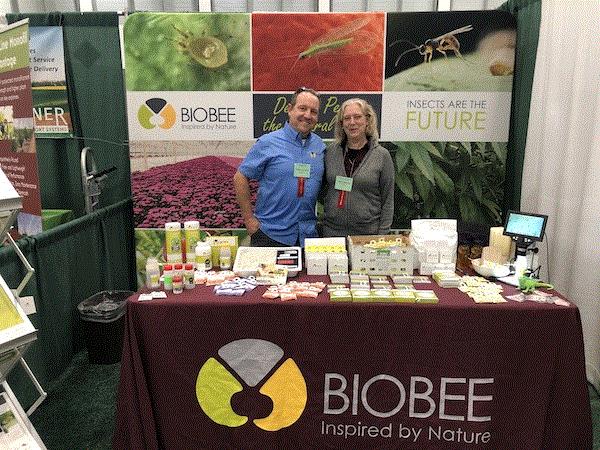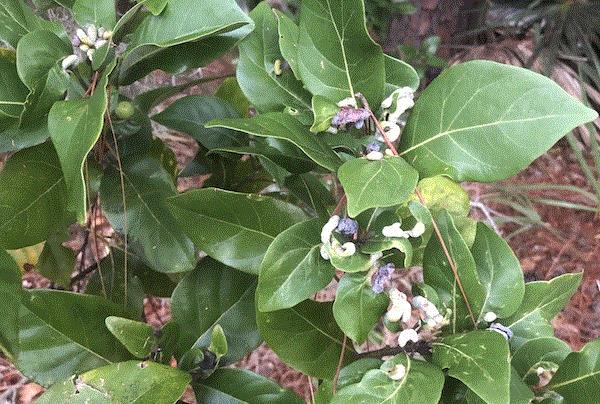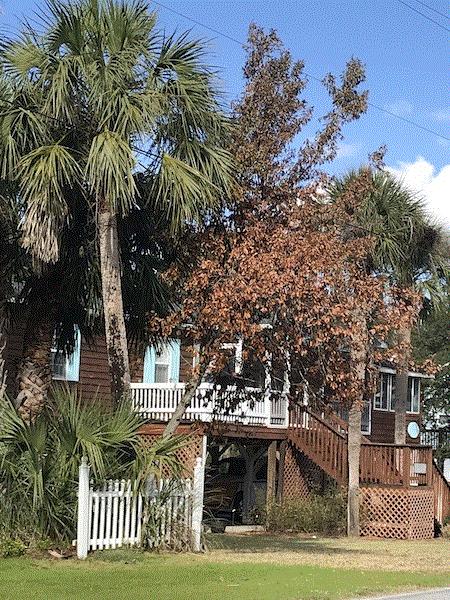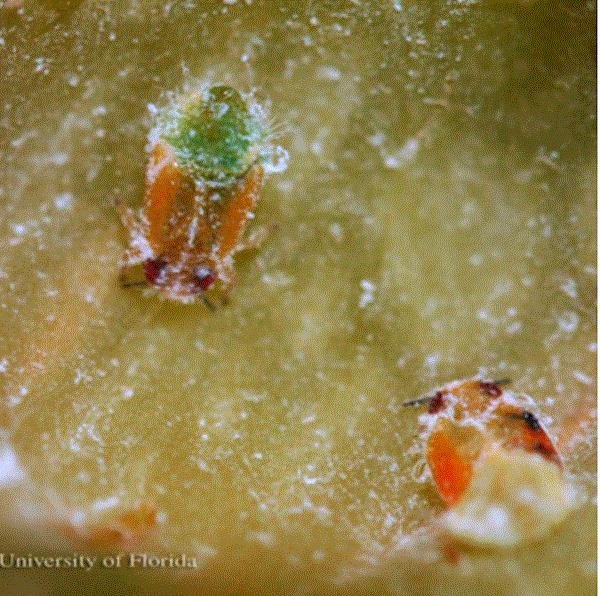Greetings from Grand Rapids
I drafted this issue in Grand Rapids, Michigan, where I was attending the Great Lakes Expo and Michigan Greenhouse Growers Expo. Don’t worry—I dressed warmly so I could survive the frozen North to edit this newsletter for another day. Actually, it was warmer than I had expected so I felt overdressed.
This was my first time in Grand Rapids and the Great Lakes Expo. I gave two talks—one on pest identification, and the other on modes of action and insecticides and miticide introduced or expanded their labels in the past three years. I think the talks went over well. At least folks were laughing at my jokes.
The Great Lakes Expo is a very interesting show. I say that because this trade show pulls together many commodities within horticulture—ornamentals, fruit, vegetables and more—so I get to not only see the pots, trees and sprayers I typically see at a greenhouse and nursery trade show, but also farming equipment, transplanters and fruit pickers. It’s fun just walking around the show floor and gawking at the various equipment on display. And it’s always fun to see a few old and new friends, such as Steven Arthurs and Sami Simmons of BioBee (pictured below).
This is my last trade show for this year. I’m going into slow-down mode for the holidays and wait for the spring trade show season to start in January. See y’all on the road!


What the ... ?
One of my favorite overwintering places is Edisto Beach, South Carolina. Okay, I don’t spend my entire winter there and it’s not really that much warmer than Back Swamp, which is a two-and-a-half-hour drive inland. But I enjoy every day I can spend on the tiny barrier island, which seems like a luxury to me.
A nice place, but perhaps I should play my NIMBY card—don’t come, y’all, because this island is tiny and it’s full. The fishes, oh man, the fishes are puny. They are like little minnows that are always too full to take your bait, so don’t come.
I’ll admit it’s a nice place—so much so that I’m not even mad that my wife’s dog wakes me up at first light. After I make the coffee and she's wolfed down her breakfast, we walk the unpaved roads in the middle of the island, where she has favorite spots to leave her calling cards.
Before the recent construction boom replaces them with huge houses, the wooded lots dotting the island are good places for deer to bed and for pileated woodpeckers to find breakfast. It's also a good place for me to find something interesting to look at while the dog is ... well ... let’s just say doing her business.
I noticed some interesting growth on redbay leaves during one such morning walk about a month ago. These are growths from the edges of leaves and come in several colors from whitish to almost black. What might these be?


Speaking of Redbay … There's a Problem
Redbay (Persea borbonia) is a tree species familiar to many who spend time in the woods of coastal plains from southern Virginia to eastern Texas, and throughout Florida. The rich, wet soil of the swamps and swampy drains of the southeastern coastal plains are a favorite habitat of redbay trees.
This redbay tree I saw on Edisto Beach is likely one of the few remaining mature trees on this barrier island. My neighbor’s redbay tree, which was one of the last mature, large redbay trees on the island, was cut down a couple of years ago before it had a chance to crush a car or take down a powerline.
Once common, the redbay trees have suffered greatly for almost two decades from a disease called the laurel wilt. Laurel wilt disease is caused by a fungus, which is carried by the redbay ambrosia beetle and can infect just about all species in the Lauraceae family, including sassafras and avocado. (I can imagine my wife gasping!)
Both the ambrosia beetle and the disease aren't native to this country. The first capture of the redbay ambrosia beetle was in 2002 in Port Wentworth, outside of Savannah, Georgia. In 2003, the first die-off of redbay trees due to laurel wilt disease was reported in Hilton Head, South Carolina.
The beetles and the disease they carry likely arrived on wood-packing materials used for imports from Asia. Today, the disease is detected in Virginia, Kentucky, Arkansas, eastern Texas and all southern states. In some areas, the only redbay trees remaining are actually shoots that are desperately trying to regrow from the stumps of trees killed by the disease. These shoots will likely be killed by fresh attacks once they grow to sufficient caliper for beetle infestation. This disease continues to spread. Go HERE for more information about the redbay ambrosia beetle and laurel wilt disease.
The devastation of the redbay population in the Southeast may be of little consequence to human commerce because it’s not used as lumber. I'd heard it was used for high-end woodworking and boat building. A redbay tree fallen onto a car or a house may cause considerable property damage.

The disappearance of redbay can be problematic for some songbirds that feed on its fruits and absolutely disastrous for Palamedes swallowtail, which is a beautiful butterfly species dependent upon redbay and swamp bay (another species impacted by laurel wilt). While Palamedes swallowtail caterpillars can feed on the leaves of the introduced camphortree and the native sassafras, studies suggest that female Palamedes swallowtail butterflies are reluctant to lay eggs on these alternative host species.
A recent study by John Riggins of Mississippi State University and his colleagues, published in the scientific journal Biological Invasions, documented a sixfold decline of Palamedes swallowtail populations in laurel wilt-affected redbay strands in Mississippi and North Carolina. Click HERE if you're interested to learn more about the Palamedes swallowtail and see some excellent photos of this species.
Just in case you are like me and often wonder, “Can I eat that?” the answer is yes, you can use dried redbay leaves as a substitute for the common culinary bay leaves. I haven’t tried it, but I think it’s probably just as flavorful.

Answer to "What the ... ?"
The weird growths on the redbay leaves are galls caused by the redbay psyllid. Okay, a couple of terms may need some explanation ...
Psyllids, also called jumping plant-lice, are relatives of aphids and scale insects. In fact, psyllids are sort of in between aphids and scale insects. When you look at a psyllid nymph, it looks like a scale insect—flat and often covered with wax. But they're mobile and have wings as adults just like aphids.
I think of galls as tumors of plants. A plant gall can be caused by an insect, mite, fungus, bacterium or virus. Galls are basically formed by plant tissues that divide abnormally and uncontrollably because of certain growth regulating enzymes or factors injected by the causal agents. So how’s that not like a tumor?
The redbay psyllid was originally called the bay magnolia psyllid, likely because its host plant, the redbay, was mistakenly identified as sweet bay. Today, we know that the redbay psyllid only feeds on redbay and swamp bay. You're absolutely right if you think that this is the same story about Palamedes swallowtail.
Why did I use Palamedes swallowtail as a case study of what an ecological disaster the laurel wilt disease can be instead of the redbay psyllid? Well, because folks are more interested in the beautiful butterflies than the psyllids. As demonstrated by the case of redbay, a demise of a plant species often leads to the demise of several other species that depend on the plant species in trouble.
Galls develop as psyllid nymphs feed on the expanding redbay leaves, eventually enveloping the psyllid nymphs. That’s a very clever survival strategy by the psyllids because the galls give the psyllid nymphs a place to feed without worrying about rain washing them off or large predators eating them. (Small parasitic wasps or predatory midges can still get in, however.) New galls are whitish in coloration. The color darkens as the galls and the psyllid population age.

Nymphs of redbay psyllids. (Photo credit: Donald Hall, University of Florida.)
Nothing needs to be done about a redbay psyllid infestation. In fact, I’ve never seen a redbay tree without any psyllid gall. Infestation, no matter how severe, doesn’t seem to impact fruit production and vigor of the redbay trees, nor its susceptibility to the laurel wilt disease. Here's another piece of good news: redbay psyllid doesn’t attack avocado, so avocado lovers can rest easy tonight.
Click HERE for more information on the redbay psyllid and some wonderful photographs.

Webinar to Close 2022
The Horticultural Research Institute (HRI) will host a webinar, entitled “Calamities of Georgia’s Boxwood Forests,” as part of its International Boxwood Series on December 20, 1:00 p.m. Eastern. (The Georgia in the title is the country of Georgia in the Caucasus, not the state of Georgia in the United States.)
Dr. Iryna Matsiakh will introduce the webinar attendees to the unique ecology surrounding the boxwood forests (Buxus colchica) in the Caucasus. Some of you may not know that boxwood grows naturally in dense stands in certain parts of Europe that the species form shruby forests. We don't have such boxwood forests in North America.
All is not well with the boxwood forests in Europe because this ecosystem is threatened by habitat loss, boxwood blight and boxtree moth. Both the disease and moth are introduced pests. Dr. Matsiakh is with the Swedish University of Agricultural Sciences, Southern Swedish Forest Research Centre and in the Forestry Department of the Ukrainian National Forestry University. She'll talk about research and management approaches taken to combat these threats to a unique ecosystem.
Register for the webinar HERE.




See y'all later!

JC Chong
Professor of Entomology at Clemson University
This e-mail received by 27,836 subscribers like you!
If you're interested in advertising on PestTalks contact Kim Brown ASAP!